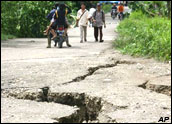Scientists have found a way to estimate an earthquake's ultimate strength by analyzing the initial seconds of a rupture -- a step that could one day provide early earthquake warning.
Currently, a quake's magnitude -- or how much energy is released -- is determined after the shaking stops, usually minutes after an event.
But researchers from the University of California, Berkeley, say the measurements of seismic waves soon after a temblor can signal whether it will be a minor or monster temblor.
Alert System
They say the information could possibly be used in an alert system to give seconds to tens of seconds of advance notice of an impending quake -- enough time for schoolchildren to take cover, power generators to trip off and valves to shut on pipelines.
"We're not taking about a massive amount of time," said Richard Allen, an assistant professor of earth and planetary science, who led the study. "But one can use our approach to come up with a magnitude before people have felt the ground shaking."
Details appear in today's issue of the journal Nature.
The study suggests different magnitude quakes begin in different ways, said Lucy Jones, the scientist in charge of the U.S. Geological Survey in Pasadena, who was not part of the study.
But Jones was skeptical that the information can be reliably used to create an early warning system. The United States is still years away from an alert system because of fears of false alarms and disagreement among scientists about what physical forces cause an earthquake to turn into a big one.
In the study, Allen and colleagues analyzed records of 71 major Pacific Rim quakes in the past decades including 24 events that were greater than a magnitude-6.
Using a mathematical model, they were able to estimate a quake's size to within one magnitude unit from as little as four seconds of data of the frequency of the energy in the primary wave. These low-energy waves typically cause a jolt, signaling the occurrence of a quake.
Estimating Outcome
Earlier research conducted by Allen showed that the first few seconds after a quake can be used to estimate quakes smaller than magnitude-6.
Allen is currently testing the model in real-time using an intricate network
of seismic instruments scattered in Northern California. ![]()
© 2005 Associated Press. All rights reserved.
© 2005 ECT
News Network. All rights reserved.

 Headline Feeds
Headline Feeds


